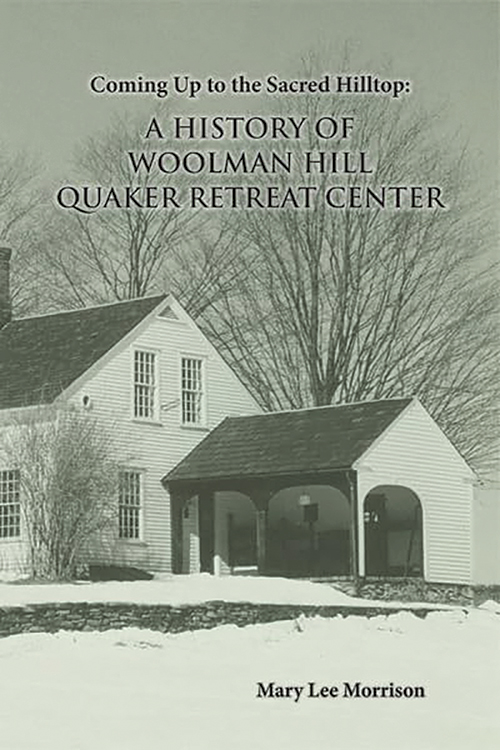
Coming Up to the Sacred Hilltop: A History of Woolman Hill Quaker Retreat Center
Reviewed by Marty Grundy
February 1, 2024
By Mary Lee Morrison. Levellers Press (Off the Common Books), 2023. 97 pages. $20/paperback.
Woolman Hill, a Quaker retreat and conference center in Deerfield, Mass., reflected liberal Friends’ intense but shifting ideals in the second half of the twentieth century. Incorporated in 1954, it lacked solidly rooted purpose and funding before the tumultuous 1960s blew in new ideals, proposals, and personnel.
The land—110 acres of meadows and woods around a hill overlooking the Connecticut River Valley—is beautiful, peaceful, and restorative. Its owner at the time, Antoinette Spruyt, was close to Jean Fairfax, an African American Quaker educator and philanthropist who was employed as college secretary for the New England Regional Office (NERO) of American Friends Service Committee (AFSC). Spruyt gave the farm to Friends associated with AFSC to develop a conference center emphasizing peace education and outreach to area colleges. Weekend seminars, work parties, meetings of major pacifist groups, conferences, and church retreats were held. A board was established, but lines of authority and responsibility were blurred among competing groups using the property, and idealism often trumped financial reality. Controversy seemed endemic.
With the help of memos, letters, draft proposals, and official minutes, the author describes one proposal after another, then writes that few ever happened. Experiments were launched with great energy and enthusiasm by new personnel and terminated a few years later as workers moved on, the board squabbled, and yet another search for new ideas and new leaders was begun.
Most projects reflected the enthusiasms of their time, long on ideals and short on details of who was to do the work and how it was to be financed. First was the close collaboration with AFSC’s NERO. There were peace conferences and summer workcamps for local and international students. In the late 1960s, an alternative school was opened with little structure and less accountability. It had 20 students at most, often fewer. When the laboriously renovated barn burned down in 1971, morale plummeted, but the school limped on until 1979.
Recalling its original purpose, the board next decided to reemphasize peace work and introduce agriculture. The Traprock Peace Center blossomed on the property with a vague and occasionally contentious connection to the board. It promoted grassroots organizing against the nuclear threat, contributing to the start of the national Nuclear Freeze campaign. In 2007, the Center moved to nearby Greenfield, Mass., as an independent organization.
In 1974, Wally and Juanita Nelson, war resisters and organic farmers, were given a small plot on which to build a simple cabin and grow organic produce to sell in the local farmers’ market. Their dedication to simple living was admired but rarely copied. Another agricultural project was fruit and nut trees.
In 1982, the board took another turn: to reestablish Woolman Hill as a conference center. Relations with New England Yearly Meeting were strengthened with retreats and weekend conferences on Quaker themes.
In 1996, the historic meetinghouse in North Dartmouth, Mass., was offered to Woolman Hill, carefully disassembled, and trucked to the Hill. After extensive fundraising, foundations were poured in 2001, and the building painstakingly reassembled.
In the twenty-first century, Woolman Hill has finally settled down with a clearer sense of its purpose. The board has matured, and consistent leadership under Margaret Cooley as executive director along with better control of finances has given Woolman Hill stability. Today it is a beloved resource for New England Friends.
Marty Grundy, a member of New England Yearly Meeting, has enjoyed several excellent retreats at Woolman Hill.
1 thought on “Coming Up to the Sacred Hilltop: A History of Woolman Hill Quaker Retreat Center”
Leave a Reply
Comments on Friendsjournal.org may be used in the Forum of the print magazine and may be edited for length and clarity.



Many thanks to Marty Grundy for her review of my recent book Coming Up the Sacred Hilltop: A History of Woolman Hill Quaker Retreat Center (February 2024) and for her affirmation that Woolman Hill is strong and thriving during the present time. Lest a reader of the review come away with the idea that there were only challenges and struggles through the first 60 years or so of Woolman Hill’s existence, which indeed there were and the reviewer highlights, I had hoped in my writing of its storied history that a reader might also come away with an understanding of the idealism that permeated the work of so many dedicated folks through the early decades who helped the Hill to become what it was and is today. This idealism, the sacred land itself that so many speak of when they come up to “the Hill” together with the hard work of many have, in good part, contributed to the resilience and staying power of Woolman Hill. Its storied history has mirrored and paralleled much of that of twentieth century Friends.